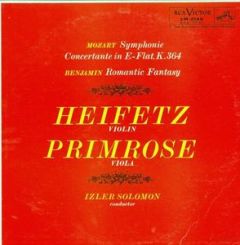Mozart: Symphonie Concertante in E-flat, K.364 – Benjamin: Romantic Fantasy (1956)
Mozart: Symphonie Concertante in E-flat, K.364 – Benjamin: Romantic Fantasy (1956)

Symphony Concertante In E-Flat, K.364 A1 First Movement:Allegro Maestoso A2 Second Movement: Andante A3 Third Movement: Presto Romantic Fantasy For Violin And Viola B1 First Movement: Nocturne B2 Second Movement: Scherzino B3 Third Movement: Sonata Jascha Heifetz - violin William Primrose – viola RCA Victor Symphony Orchestra Izler Solomon – conductor
The magnificent Sinfonia concertante for violin, viola, and orchestra in E flat major, K. 364, is Mozart's only surviving complete work of this type, a genre that incorporates elements of both the symphony and concerto. Generally scored for two or more solo instruments and orchestra, the sinfonia concertante was particularly popular in Paris in the eighteenth century. It was there, in fact, that Mozart composed such a work in 1778 for four outstanding wind soloists from the Mannheim orchestra who were also then in the French capital; that work, however, is now known only in a spurious nineteenthth century edition.
During this period Mozart also began two other works in the sinfonia concertante genre, one for violin and piano in D major (1778), and another for violin, viola and cello in A major, K. 320e (ca. 1779-1780), neither of which progressed beyond the first 130 or so measures before the composer set it aside. The present work may be a replacement for the aborted D major work. It was composed in Salzburg during the summer or fall of 1779, about the same time as that work. In both works, Mozart calls for a higher tuning than is usual for the viola; his purpose in so doing was undoubtedly to give the instrument a brighter sound to avoid being overshadowed by its more penetrating violin companion.
The soloists for whom the Sinfonia concertante was composed are not known, but they may have been Antonio Brunetti, the leader of the Salzburg court orchestra, and the violinist Joseph Hafender. The work is in three movements: Allegro maestoso, Andante and Rondo. The orchestra includes two oboes, two horns, an optional pair of bassoons, and strings. The work is notable for its warm expansiveness; the Andante is particularly delectable with its ravishing dialogue between the two soloists. The scoring is unusually full and rich; Mozart's frequent divisi writing for the violas produces textures that presage the sumptuous writing in Idomeneo, ré di Creta (1781), the opera seria composed for Munich less than a year later. ---Brian Robins, Rovi
The Romantic Fantasy for violin and viola is a substantial piece lasting well over twenty minutes. It was composed in 1936 in response to a request from the great violist Lionel Tertis. The score is dedicated to Arnold Bax. In fact, Lewis Foreman has noted the opening theme of the work quotes the ‘faery horn theme from Bax’s In the Faery Hills’. The work is in three well-balanced movements with an opening Nocturne, a Scherzino and a Sonata-Finale. However the design of the piece allows the movements to slip into each other. The combination of violin and viola in concerted form is somewhat unusual. Yet Benjamin’s mastery of technique and orchestral colouring makes this seem perfectly natural. In fact the instruments do not compete: they support, comment and engage with each other. However, this is not a simple work, there sounds to be difficulties on every page. In fact, William Primrose, who recorded this work, has noted the tricky cadenzas in this work, not only for the soloists but also for the ensemble. I am sure that the Romantic Fantasy tells a story. Yet we are not going to find just what that narrative was. I guess that the title balances both generally used meanings of the word ‘romance’. Certainly the reprise of the gorgeous opening theme at the very end is a master stroke. It is guaranteed to bring a tear to a glass eye.
If the listener is looking for an antecedent for this work he could worse than to imagine influences from William Walton, Arnold Bax, Frederick Delius –and dare I say it Erich Wolfgang Korngold! The Romantic Fantasy was first issued on RCA in 1965 with Heifetz and Primrose as the soloists. --- John France, www.musicweb-international.com
download (mp3 @320 kbs):
uploaded yandex 4shared mega mediafire zalivalka cloudmailru oboom uplea








